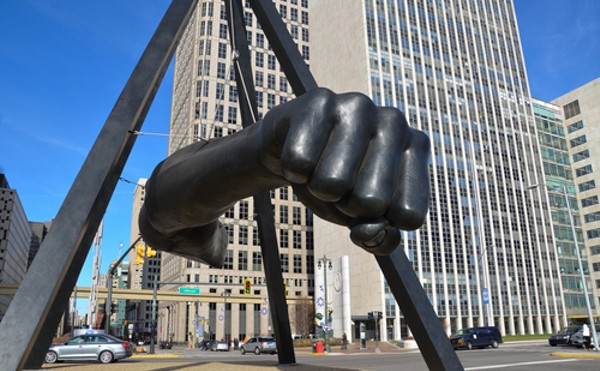Although specifics differed, as budgets for the coming school year were set, Michigan's public universities began issuing press releases with a similar tone: They were working hard to put a positive spin on unwelcome news.
All the schools, dealing with anticipated cuts in funding from a state government in the throes of a massive budget shortfall, were announcing tuition hikes.
"The economic challenges for students, their families and the state are severe and unprecedented," Susan Martin, president of Ypsilanti's Eastern Michigan University announced, echoing the concerns of her counterparts across the state. "Particularly in this environment, we felt it was essential to keep tuition as low as possible and to increase student aid."
But the bottom line is the same at every public university in Michigan. In anticipation of another round of state funding cuts, tuition is being raised.
Again.
From Lake Superior State University in Sault Ste. Marie to Western Michigan University in Kalamazoo to Wayne State in Detroit, school leaders were announcing increases ranging from 3 percent to more than 6 percent.
It has become an annual rite, as predictable as leaves changing color in autumn, these announcements that the cost of attending college would be going up.
Again.
As the nonprofit think tank the Center for Michigan points out, the equation is fairly straightforward. College revenue primarily comes from two sources: state funding and tuition. And as state funding declines, the pressure to increase tuition grows. The center points out that over the past five years, as "campus spending continues to outpace inflation and state taxpayer support for university operations has dwindled," tuition charged by each of Michigan's 15 public universities has "ballooned" from 40 percent to as high as 118 percent. (Each Michigan university is autonomous, setting its own budget, tuition and fees.)
According to the nonprofit Delta Project on Postsecondary Education Costs, Productivity and Accountability, state support for public university students lags far behind the national average — about $5,300 a year per student at Michigan's top colleges compared to abut $7,100 nationally. In addition, as the Center for Michigan points out, "Michigan students are paying a dramatically larger share of the costs of their education than they did just a few years ago."
The House Fiscal Agency, which provides nonpartisan budget analysis, reports that state support per pupil has fallen more than 16 percent between 2001-'02 and 2007-'08, with the average falling from $6,853 to $5,719. As a result, the Delta Project reports, Michigan students a shouldering a larger share of college costs than the national average.
However, if inflation is taken into account, the decrease in state support has actually been much more precipitous. The Presidents Council, State Universities of Michigan, a Lansing-based nonprofit association serving Michigan's 15 state universities, reports that, compared to 2001, in terms of real dollars, "state budget cuts have reduced per student spending by $2,852. In other words, if the $6,869 allotted each student in 2001 had simply been adjusted upward to keep pace with inflation, the figure would now be $8,557 instead of the current $5,705.
"We are losing ground considerably when it comes to preparing our young people to succeed," says Michael Boulus, executive director of the Presidents Council. "That should be of concern to our policymakers, and it should be of concern to all the rest of us, because we all have a vested interest in an educated citizenry."
As a graph at the Presidents Council Web site (pcsum.org) makes clear, in what Boulus calls our "knowledge-based economy," the more education a person has, the more they are likely to earn. It follows that the more people earn, the more revenue — in the form of income taxes — is available to the state; the flip side of that is, if that educated workforce isn't available, jobs are going to go elsewhere.
Writing about the issue for the Center for Michigan, John Bebow points out that, "even after financial aid is considered, students attending Michigan's seven institutions considered to be research universities paid 63 percent of the cost of education in 2006, up from 49 percent just four years earlier. Nationally, students in 2006 paid 51 percent of costs to attend public research universities."
Although it has accelerated in recent years, this trend of shifting burdens began decades ago.
In a July 2009 report issued by the center, Judy Putnam drew attention to a startling statistic: "In 1973, state support paid for 75 percent of the universities' general fund; last year, state support accounted for just 33 percent."
When it comes to students facing increasingly higher costs, Michigan is far from alone. According to one report issued in January of this year, the average price of attending a public university per year nationally increased from $13,096 in 2002-03 to $16,836 in 2006-07. In Michigan, during that same period, the average cost rose from $13,929 to $17,241.
Although the upward pressure is a national trend, Michigan, which began its economic downturn earlier than most other states, is dead last when it comes to the percentage of financial support for its universities.
As the presidents and boards of regents of every public university in Michigan pointed out when announcing tuition hikes this summer, the schools were also making big increases in the amount of student aid available to help offset the tuition increases. But even in the area of support for financial aid, Michigan is lagging behind many states.
Citing a study recently issued by the Michigan House Fiscal Agency, the Center for Michigan reports that "Michigan taxpayers provide $227.5 million in direct state funding for financial aid." That represents an increase of more than $120 million since 1998.
However, the report notes: "Despite that funding increase, Michigan is losing what amounts to a national arms race in financial aid. Michigan ranks 22nd nationally in financial aid grants per student, and doles out less than one-third as much financial aid as leading states like South Carolina and Georgia. While Michigan financial aid is up 131 percent since 1996-97, that ranks only 27th nationally. Leading states, including Montana, Tennessee and South Carolina have increased financial aid ten-fold or more."
The answer to bringing down costs for students and making Michigan more competitive economically, Boulus says, is to take a step many legislators are reluctant to take: increase taxes. In a recent opinion piece is co-written with Kyle Caldwell, president of the Michigan Nonprofit Association, the two argued that "If Michigan's state tax burden were the same as in 2000, state revenues would be $7.5 billion higher. Instead, the Legislature and governor are again are struggling to cut their way to a balanced budget by slashing programs and services by $1.8 billion. Until the state tax structure is updated, each year Lansing will continue to reduce funds for local police and firefighters, water and sewage systems, the State Police, veterans needs, child protective services, health care for children and the elderly, public schools and colleges and universities."
"This isn't to say fundamental reforms are not part of a prescription for fixing the budget," they explain. "But it should be clear to politicians that they also must reform the state's tax system to preserve Michigan's quality of life to attract and retain the young talented college graduates who are fleeing to other states — many with higher tax burdens than Michigan — to find a place where they will build their futures."
Curt Guyette is Metro Times news editor. Contact him at 313-202-804 or [email protected]




